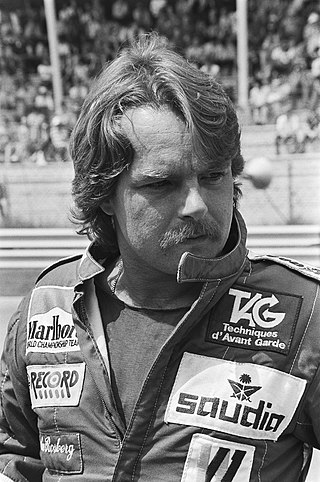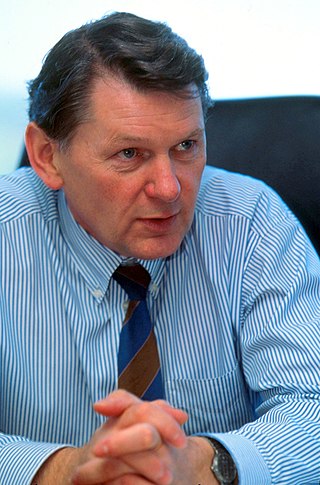McLaren Racing Limited is a British motor racing team based at the McLaren Technology Centre in Woking, Surrey, England. McLaren is best known as a Formula One chassis constructor, the second oldest active team and the second most successful Formula One team after Ferrari, having won 183 races, 12 Drivers' Championships and 8 Constructors' Championships. McLaren also has a history of competing in American open wheel racing, as both an entrant and a chassis constructor, and has won the Canadian-American Challenge Cup (Can-Am) sports car racing championship. The team is a subsidiary of the McLaren Group, which owns a majority of the team.

Alain Marie Pascal Prost is a French retired racing driver and Formula One team owner. A four-time Formula One World Drivers' Champion, from 1987 until 2001 he held the record for most Grand Prix victories until Michael Schumacher surpassed Prost's total of 51 victories at the 2001 Belgian Grand Prix.

Keijo Erik Rosberg, best known as "Keke", is a Finnish former racing driver and winner of the 1982 Formula One World Championship. He was the first Finnish driver to win the championship. He is the father of Nico Rosberg, the 2016 Formula One World Champion.

BMW has been involved in Formula One in a number of capacities since the inauguration of the World Drivers' Championship in 1950. The company entered occasional races in the 1950s and 1960s, before building the BMW M12/13 inline-four turbocharged engine in the 1980s. This engine was the result of a deal between BMW and Brabham, which resulted in the team's chassis being powered by BMW engines from 1982 until 1987, a period in which Nelson Piquet won the 1983 championship driving a Brabham BT52-BMW. BMW also supplied the M12/13 on a customer basis to the ATS, Arrows, Benetton and Ligier teams during this period, with various degrees of success. In 1988, Brabham temporarily withdrew from the sport and BMW withdrew its official backing from the engines, which were still used by the Arrows team under the Megatron badge. Turbocharged engines were banned by the revised Formula One Technical Regulations for 1989, rendering the M12/13 obsolete.

Andrea de Cesaris was an Italian racing driver. He started 208 Formula One Grands Prix but never won. As a result, he holds the record for the most races started without a race victory. A string of accidents early in his career earned him a reputation for being a fast but wild driver.

Gerhard Berger is an Austrian former Formula One racing driver. He competed in Formula One for 14 seasons, twice finishing 3rd overall in the championship, both times driving for Ferrari. He won ten Grands Prix, achieved 48 podiums, 12 poles and 21 fastest laps.
Ian Gordon Murray, is a South African-British designer of Formula One racing cars for Brabham and McLaren and the McLaren F1 high-performance road car. Founder and CEO of Gordon Murray Design and Gordon Murray Automotive he has subsequently designed and built a number of sports cars and a variety of other automotive vehicles.

John Edward Barnard, is an English engineer and racing car designer. Barnard is credited with the introduction of two new designs into Formula One: the carbon fibre composite chassis first seen in 1981 with McLaren, and the semi-automatic gearbox which he introduced with Ferrari in 1989.

The 1984 Monaco Grand Prix was a Formula One motor race held at Monaco on 3 June 1984. It was race 6 of 16 in the 1984 FIA Formula One World Championship. It was the only race of the 1984 championship that was run in wet weather.

The 1985 Australian Grand Prix was a Formula One motor race held on the Adelaide Street Circuit in Adelaide on 3 November 1985. The sixteenth and final race of the 1985 Formula One World Championship, it was the 50th running of the Australian Grand Prix and the first to be held on the streets of Adelaide on a layout specifically designed for the debut of the World Championship in Australia. The race was held over 82 laps of the 3.780 km (2.362 mi) circuit for a total race distance of 310 kilometres. The race was won by Keke Rosberg driving a Williams-Honda; this was the final win for Rosberg, the last race for Alfa Romeo until 2019, and the last by a Finnish driver until Mika Häkkinen won the 1997 European Grand Prix.
Fittipaldi Automotive, sometimes called Copersucar after its first major sponsor, was a Formula One racing team and constructor that competed from 1975 to 1982. It was the only Formula One team to have been based in Brazil. The team was formed during 1974 by racing driver Wilson Fittipaldi and his younger brother, double world champion Emerson, with money from the Brazilian sugar and alcohol cooperative Copersucar. The team raced under a Brazilian licence. Emerson Fittipaldi became a driver for the team in 1976 after leaving McLaren, but was unable to replicate his earlier success with the family-owned team. Future world champion Keke Rosberg took his first podium finish in Formula One with the team.
Stephen South is a British former racing driver from England. He was educated at Harrow County School for Boys.

The McLaren MP4/2 was a Formula One car produced by McLaren for the 1984 season. An iteration of it, the MP4/2B, was used in the 1985 season, and a slightly updated version, the MP4/2C, raced in the 1986 season for McLaren. It was closely based on the MP4/1E model that was used as a test car, used in the final races of 1983.

The McLaren MP4/5, and its derived sister model, the McLaren MP4/5B, were highly successful Formula One racing cars designed by the McLaren Formula One team based in Woking, England, and powered by Honda's naturally-aspirated RA109E and RA100E V10 engines respectively. The chassis design was led by Neil Oatley, teaming up with Steve Nichols, Pete Weismann, Tim Wright, Bob Bell and Mike Gascoyne. As with the previous designs, Gordon Murray, as Technical Director, had the role of liaising between the drawing office and production. Osamu Goto was the Honda F1 team chief designer for the car's engine.

The McLaren MP4/1 was a Formula One racing car produced by the McLaren team. It was used during the 1981, 1982 and 1983 seasons. It was the second Formula One car to use a monocoque chassis wholly manufactured from carbon fibre composite, after the Lotus 88, a concept which is now ubiquitous. The MP4/1 was first entered in a Formula One race at the third grand prix of the season in Argentina.

The McLaren M26 was a Formula One racing car designed by Gordon Coppuck for the McLaren team, to replace the aging McLaren M23 model. The car was designed to be a lighter and lower car than its predecessor, with a smaller frontal area and narrower monocoque. Coppuck began design work in early 1976, with a view to introducing the car in the mid season.

The McLaren M2B was the McLaren team's first Formula One racing car, used during the 1966 season. It was conceived in 1965 and preceded by the M2A development car. Designed by Robin Herd, the innovative but problematic Mallite material was used in its construction. The car was powered by Ford and Serenissima engines but both lacked power and suffered from reliability issues.

The McLaren M7A and its M7B, M7C and M7D variants were Formula One racing cars, built by McLaren and used in the world championship between 1968 and 1971. After two relatively unsuccessful years of Formula One competition, the M7A was used to score McLaren's first win at the 1968 Belgian Grand Prix.

The McLaren M29 is a Formula One racing car built and run by McLaren during the 1979 Formula One World Championship and the 1980 Formula One World Championship. The F version of the McLaren M29 was built in 1979, but only ran during five races of the 1981 Formula One World Championship. The M29F was the last of the M-numbered cars to be raced, as later in the season, the McLaren MP4/1 was readied for use in the championship.

The McLaren MCL32 is a Formula One racing car designed and constructed by McLaren to compete in the 2017 FIA Formula One World Championship. The car was driven by two-time World Drivers' Champion Fernando Alonso, who stayed with the team for a third season; and Stoffel Vandoorne, who joined the team after Jenson Button retired from full-time competition at the end of the 2016 season.
















